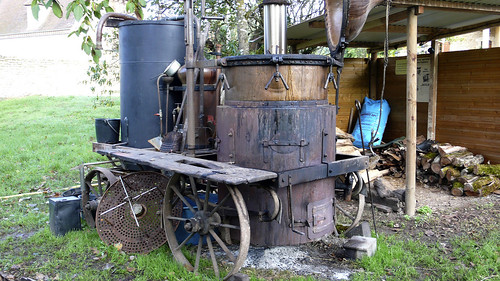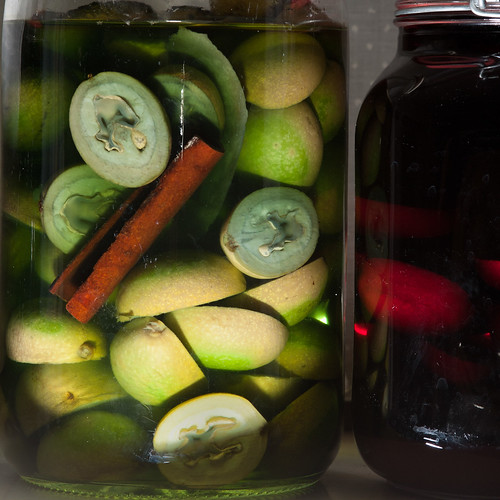
Recipes
Today’s Saints day is for St. John the Baptist. This is the traditional day, in France and Italy, for making Walnut Liqueur (Nocino) and Walnut Wine (Vin Noix).
At this time, at least in southern Europe, the walnuts are ready to use. They are not ripe yet but they are well enough formed for these uses. When cut in half, which is not easy, they should have a jelly-like constituency and the development of the nut should be visible. In more northern parts you may have to wait a few more weeks.
When handling the nuts be aware that they will stain your fingers. Kitchen gloves might be useful.
The image above shows a mobile still used for making spirits, usually Eau de Vie. These stills are operated by old fellas, in the south of France, who still have the license to operate them. Apparently no new licences are to be given so when these men are gone then so will the sight of these stills around the countryside be gone. A sad state of affairs. The distiller traditionally travels from farm to household, to village and you bring your own excess fruit to be distilled. Any one is allowed to make 10 litres of spirit for personal use only. I believe you have to pay a certain amount in tax too.
When I came across this still, in October time in the Dordogne region of France, they were making Eau de Vie from plums. At first I thought it was an illegal still but they explained everything to me and showed me the posters explaining the rules. However they did bend the rules and sell me a wine bottle full of the stuff!
This type of home-made Eau de Vie is the one traditionally used to make the recipes below. Obviously the Eau de Vie is from the previous season!
Walnut Liqueur (Nocino)
30 Green Walnuts, halved
1 litre of alcohol, perhaps Eau de Vie, Genever or Vodka
1 stick of cinnamon
3 or 4 cloves
A strip or two of citrus peel
Place all these in a sterilised jar, a Kilner jar with a clamped top is good, and leave on the window-sill for about 30 or 40 days. Shake from time to time. It will gradually become a deep brown colour.
After this strain the liquid through a muslin cloth. At this point you can dilute it and sweeten it by mixing in some water in which you have dissolved some sugar. A litre of water and 250 grammes of sugar is suggested. But this is a taste thing.
Bottle the resultant liquid, using sterilised bottles, and leave for at least a year, preferably two.
Walnut Wine (Vin Noix)
5 Green Walnuts chopped small enough to get into your container
1 litre of Red Wine
200 grammes of Sugar
Put all these together in a container, a Kilner jar, or a demijohn (Bonbonne), which has been sterilised. Leave to fuse for about 30 or 40 days.
If using a demijohn then multiply the quantities to fill it. For 5 litres of wine, use 25 Walnuts and a kilo of sugar (and a litre of alcohol later - see below)
After the wait strain the liquid through a muslin cloth and add 200 ml of Eau de Vie (or other alcohol) and put into sterilised bottles. You can use it after 6 months but leaving longer is better.

The first day. The liqueur is on the left and the wine on the right.

